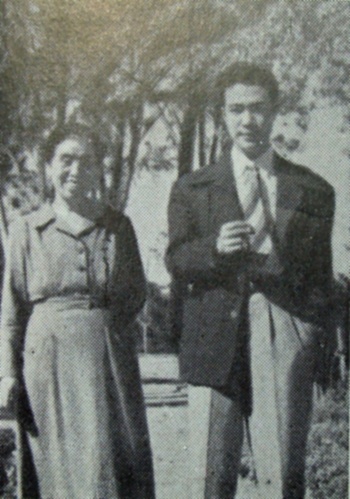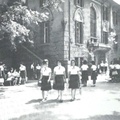While studying the history of performing arts and Japanese literature, folklorist Orikuchi Shinobu proposed the concept of "tales of the wandering nobleman" as the prototype of narrative literature in Japan.
The story is about someone of high status, such as royalty or aristocrat, being abandoned for some reason and forced to leave their home, being placed in unfortunate circumstances or on the lower world, where they go on journeys and adventures to demonstrate their righteousness or some kind of power. This is a series of stories that has been around since the time of Greek mythology, such as Kaoru Kurimoto's heroic fantasy novel "Guin Saga."
In what could be considered a Brazilian version of "Tales of the Wandering Noble," the families and relatives of famous Japanese people have left their supposedly glamorous lives in Japan to the most remote place on Earth.
Other immigrants before the war included Hayashi Ise (deceased), the younger sister of Tanizaki Junichiro, the novelist famous for his aesthetic works such as "A Fool's Love," "The Tale of Shunkin," and "The Makioka Sisters," as well as Tokugawa Yoshitada, grandson of Tokugawa Yoshikatsu, the 14th and 17th head of the Owari Tokugawa clan, and his wife Ayako (Ayako was the eldest daughter of Kuroda Nagayoshi of the Chikuzen Akizuki clan, and both now deceased).
According to the October 2008 issue of the monthly magazine Geography (Kokon Shoin), Yoshino Tomoko, the niece of Yoshino Sakuzo, an advocate of democracy, who graduated from a women's normal school and emigrated to Brazil after graduation. Others who came to Brazil included Soma Fumio, the third son of Soma Aizo and his wife Kokko, of Shinjuku Nakamuraya, who are known for helping Rash Behari Bose, a patriot of the Indian independence movement who fled to Japan; So, nephew of poet Yosano Tekkan; and Ota Hidetoshi, nephew of Nitobe Inazo, whose son is also featured on a banknote.
After the war, there was Setsuko Tange, the daughter of entertainer Kiyoko Tange, who hosted the Red Team at the 2nd Red and White Song Battle in 1952. In an era when people could not watch NHK international broadcasts, she gathered talented immigrants together to form a traveling troupe of performers, visiting remote settlements and performing Japanese popular entertainment, which earned her tearful thanks from elderly immigrants she had not seen for decades.
Among the many such "nobles," the most outstanding was Mr. Tarama Toshihiko, who was described as "his arrival in Brazil in April 1951, so moved his compatriots in Brazil that it was rumored to be the 'descent of the heavenly grandson of the Showa era'" (Biographies of Japanese Pioneers in Brazil, p. 142, Paulista Newspaper Company, December 1955).
In the overseas Korean community, where immigrants are generally looked down upon as "stragglers" in their home country, their presence makes people think "Wow, there are all kinds of immigrants out there," and they have a presence that adds a touch of glamour, so to speak.
Emperor Meiji's grandson emigrated to Brazil
On April 16, Toshihiko Tarama (86 years old, born in Tokyo) died of a heart attack at his home in the city of São Paulo. Born as the fourth son of Prince Higashikuni and Princess Satoko, he was affectionately known as "His Highness Tarama" in the Japanese community.
His father was Prince Higashikuni Naruhiko (1887-1990). His mother's maiden name was Princess Yasunomiya Satoko, the ninth daughter of Emperor Meiji. In other words, he is Emperor Meiji's grandchild on his mother's side. When people met Tarama, they asked him about his lineage, as if it were a "promise." At that time, he often said, "Looking at the grandchildren of Emperor Meiji, the eldest was Emperor Showa, and the youngest was me."
Emperor Meiji had no children with the Empress, but had five boys (including Emperor Taisho) and ten girls with his concubines. Emperor Taisho was the only boy who reached adulthood, and all of his adult children, except for Princess Fusako (wife of Kitashirakawa) and Princess Yasunomiya Toshiko (wife of Higashikuni), died young before their fifties.
In other words, Tarama-san is the fourth son of four siblings born to Princess Satoko Yasumiya, the youngest surviving son of Emperor Meiji, and this is exactly what he himself said. In other words, he has the lowest chance of succeeding to the throne.
Former Imperial Family Members Who Moved Early After the War
Two years before the official start of the postwar migration, Tarama arrived in April 1951 on a plane, which was very rare at the time. Japanese-language newspapers reported on him extensively every day. The Paulista Shimbun newspaper of April 1st reported on his arrival in Brazil, saying, "The subject of much discussion, Higashikuni leaves Yokohama for his journey to Brazil." The newspaper of April 21st reported on his arrival in Rio de Janeiro, the capital at the time, in the top right corner, saying, "His longed-for land he set foot on, Higashikuni Toshihiko arrives yesterday in Brazil to become a simple farmer." The newspaper of April 24th reported on his arrival in São Paulo in the top left corner, saying, "Cheerful and good-natured young man Higashikuni Toshihiko arrives in good spirits." It also interviewed him directly.
The first post-war Consul General Ishiguro Shiro was appointed in December 1951. The first post-war ambassador Kimizuka Makoto was appointed in September 1952, and the first group of post-war immigrants arrived at the port of Santos in January 1953, so you can see how early Tarama came.
The San Francisco Peace Treaty, which restored Japan's sovereignty, was signed in September 1951, and Tarama was able to emigrate at such an early date because he was adopted by a permanent resident of Brazil, which was a form of "family reunion."
His adopted son, Tetsusuke Tarama, worked for the Consulate General in Sao Paulo before the war and was instrumental in the construction of the Hirano Colony, which was established in 1915, and the Alianca region, which was the forerunner of the construction of large settlements. After retiring from the government, he immigrated to Brazil as an immigrant and managed a coffee plantation in Lins on the Noroeste railway line.
Immediately after the outbreak of World War II, he was encouraged to return to Japan on an exchange ship, but he decided to "stay with the immigrants" and passed away here in 1942. Tarama was adopted by Kinu's widow.
© 2015 Masayuki Fukasawa








